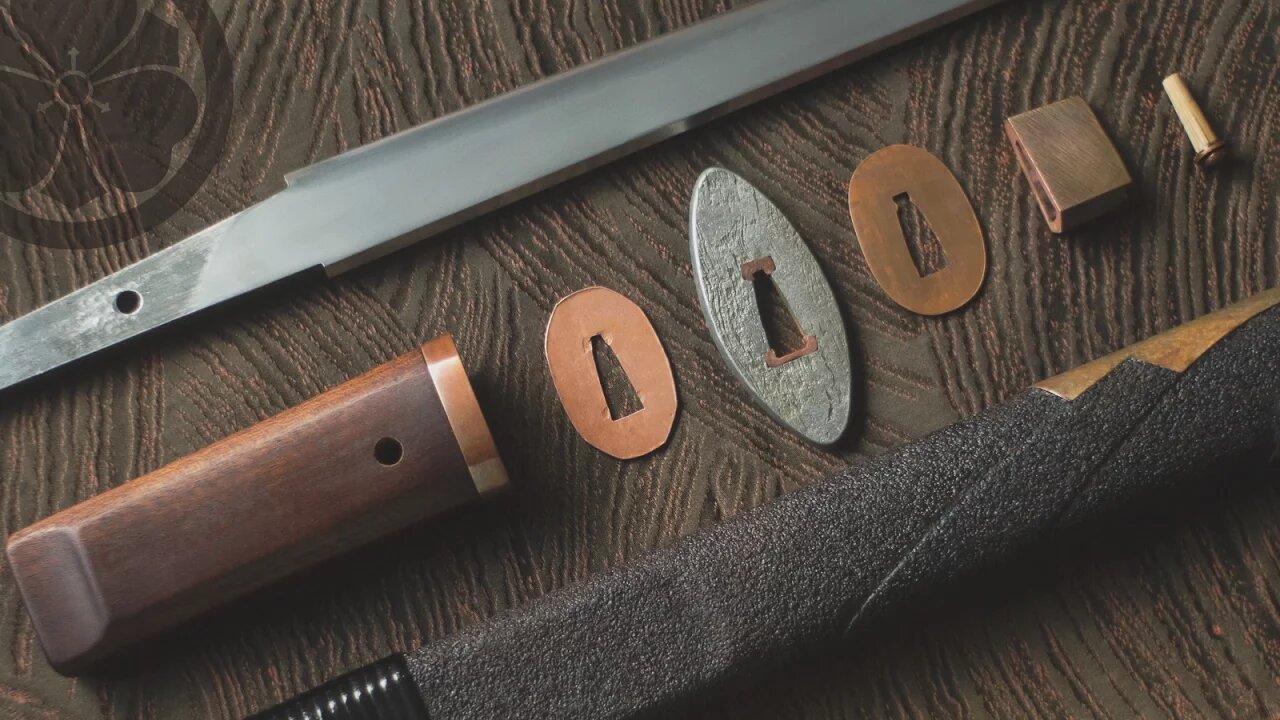Premium Only Content

One bamboo peg - takedown & assembly of a classical tanto style knife
A demonstration on the takedown and assembly of classical tanto style knives. http://islandblacksmith.ca/2016/10/takedown-reassembly-classical-tanto-style-mountings/
Never pull or jerk the blade out with the power of your arms or you will lose control of the blade and possibly damage the saya (scabbard), yourself, or others. When unsheathing, make sure the edge is up, then pull just enough (a few mm) so that the habaki (blade collar) disengages its tight hold on the saya, then the blade may be easily and smoothly drawn, resting on the mune (spine) as it slides out.
One way to accomplish the initial part of the draw is to place a hand loosely on either side of the joint, topmost thumb knuckles together and then squeeze. The knuckles push against each other for only a short distance but it is enough to start the blade out in a controlled manner (this way is slightly more difficult and may take some practice). Another method is to grasp the tsuka (handle) and saya tightly with a little space between your hands and then use your saya thumb or forefinger to push against the other hand or against the tsuba (handguard), if it has one, until the release.
To replace the blade in the saya, make sure the edge is up, rest the tip in the koiguchi (mouth of the scabbard), and slide it in smoothly, keeping the edge up and resting it on the mune (spine) until the habaki engages again.
Storage & Handling
1. never touch the blade directly, hold the tang below the polished area instead.
2. store and display with the edge up and the handle to the left side.
3. keep in a secure, dry location in a sturdy storage bag.
4. if possible, keep the blade in shirasaya, apart from the fittings and mountings.
5. use a thumb against the guard or hand, or the squeeze technique to open the first few mm without pulling.
6. slide the blade out carefully along the spine with the edge upwards to avoid scuffing the blade or cutting the scabbard.
7. avoid condensation from temperature changes or breathing on the blade.
8. avoid wide temperature ranges or quick temperature or humidity changes to the wood.
9. keep lacquered parts out of long-term direct sunlight.
10. when closing, set the back of the tip inside the koiguchi (mouth of the scabbard) and then slide in carefully along the spine.
Disassembly & Reassembly:
1. remove the scabbard before disassembly.
2. remove the mekugi peg by pressing from the back side with a thin piece of wood or mekugi-nuki tool.
3. loosen by pressing the guard or gently striking the hand that is holding the handle.
4. work the fingers under the guard and grasp the tang before removing the handle.
5. take note of the order and direction of each component as it is removed.
6. reassemble in reverse order, taking care not to force any part (check the order, fit, and placement instead)
7. tap the pommel into your palm until the tang is fully seated in place.
8. ensure that the mekugi is aligned rotationally so that the long, straight, unbroken bamboo fibers face back towards the pommel.
9. insert from the correct side of the handle and press into place until flush or appropriately tight, do not overdrive.
10. check that everything is snug and all parts are in their proper places before sheathing.
Cleaning & Maintenance:
1. remove fittings from the blade before oiling.
2. remove old oil and dust with washi paper, tissue paper, or clean cotton cloth.
3. wipe slowly from base to tip with the edge away from fingers.
4. place a few drops of clove/camellia oil on a clean cotton cloth.
5. wrap the cloth around the spine with the edge away from your fingers.
6. wipe on a thin layer of oil starting from the polished area under the habaki towards the tip.
7. remove any excess with a second pass if necessary.
8. oil weekly to monthly depending on the climate and storage conditions.
9. the oil can be used sparingly on other iron fittings as well (such as the handguard).
10. sharpening and polishing should only be performed by specialized polishers.
read more here:
http://islandblacksmith.ca/knife-use-and-care/
more about these knives:
http://islandblacksmith.ca/2015/12/touzai-fusion-tanto/
http://islandblacksmith.ca/2014/09/tsukimi-tanto/
-
 LIVE
LIVE
EricJohnPizzaArtist
6 days agoAwesome Sauce PIZZA ART LIVE Ep. #54: I WANT MY PUDGE TV!
341 watching -
 2:08:06
2:08:06
Nerdrotic
3 hours ago $6.28 earnedLost History of Ancient Peru with Pillars of the Past | Forbidden Frontier #108
24.1K2 -
 LIVE
LIVE
IsaiahLCarter
1 day ago $2.00 earnedFighting Crime in NYC, For Real This Time || APOSTATE RADIO EPISODE 023 (Guest: Maud Maron)
374 watching -
 LIVE
LIVE
MissesMaam
2 hours agoCan We Find All The Artifacts ?!? 💚✨
45 watching -
 LIVE
LIVE
Damysus Gaming
41 minutes agoDune: Awakening - The Grind Continues - Pushing to Complete More Story Night 3!!!
7 watching -
 2:44:54
2:44:54
vivafrei
11 hours agoEp. 272: Epstein Debacle Continues! Federal Courts Still Going Rogue! Russia-Gate Exposed & MORE!
269K127 -
 3:45
3:45
Blackstone Griddles
5 hours agoSimple Smashburgers with Burger Sauce on the Blackstone Griddle
17.3K3 -
 LIVE
LIVE
NeoX5
6 hours agoThe Fastest Player Around! | Part 1 | Summer Gaming Ep 21 | Rumble Gaming
53 watching -
 LIVE
LIVE
iCheapshot
1 hour ago $0.01 earnedTony Hawk 3+4 Type Ishh
56 watching -
 15:45
15:45
The Car Guy Online
6 hours ago $1.54 earnedGM’s ‘Own Nothing, Be Happy’ Plan! Former Engineer Blows Whistle.
13.6K5